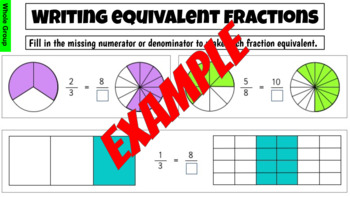Equivalent Fractions-Differentiated Activities
The Messy SpEd Teacher
156 Followers
Grade Levels
3rd - 5th
Subjects
Resource Type
Standards
CCSS3.NF.A.3
CCSS3.NF.A.3a
CCSS3.NF.A.3b
CCSS4.NF.A.1
Formats Included
- Google Slides™
Pages
7 pages
The Messy SpEd Teacher
156 Followers

Made for Google Drive™
This resource can be used by students on Google Drive or Google Classroom. To access this resource, you’ll need to allow TPT to add it to your Google Drive. See our FAQ and Privacy Policy for more information.
Description
This activity includes a whole group activity on identifying equivalent fractions.
3 levels of differentiated activities follow that for use with students of varying levels in your classroom. Level 1 has students build equivalent fraction models with manipulative pieces. Level 2 has students solve equivalent fractions with the given "magic number" to multiply. Level 3 looks at cross multiplying to determine whether the fractions are equivalent or not.
Enjoy!
The Messy SpEd Teacher
Total Pages
7 pages
Answer Key
Not Included
Teaching Duration
90 minutes
Last updated Feb 1st, 2021
Report this resource to TPT
Reported resources will be reviewed by our team. Report this resource to let us know if this resource violates TPT’s content guidelines.
Standards
to see state-specific standards (only available in the US).
CCSS3.NF.A.3
Explain equivalence of fractions in special cases, and compare fractions by reasoning about their size.
CCSS3.NF.A.3a
Understand two fractions as equivalent (equal) if they are the same size, or the same point on a number line.
CCSS3.NF.A.3b
Recognize and generate simple equivalent fractions, (e.g., 1/2 = 2/4, 4/6 = 2/3). Explain why the fractions are equivalent, e.g., by using a visual fraction model.
CCSS4.NF.A.1
Explain why a fraction 𝘢/𝘣 is equivalent to a fraction (𝘯 × 𝘢)/(𝘯 × 𝘣) by using visual fraction models, with attention to how the number and size of the parts differ even though the two fractions themselves are the same size. Use this principle to recognize and generate equivalent fractions.





